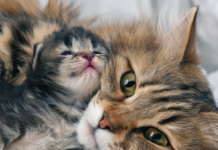Keeping your cat safe in the summer months takes a little forethought. During extremely hot, humid weather, cats are increasingly vulnerable to heat exhaustion and dehydration. The most common crisis is when a cat is left in an automobile, for even just a few minutes. The initial signs of feline heat exhaustion include rapid panting, muscle weakness, staggering, rapid heartbeat, fainting, tremors, and possibly vomiting. If the overheating (hyperthermia) is unrelieved and the cat’s body temperature reaches 105°F or higher, cell damage begins, which can result in kidney, liver, and gastrointestinal dysfunction, lowered levels of blood oxygen, destruction of skeletal muscle tissue, impaired brain function, heart failure, and death.
Obese and older cats are at greater risk for heatstroke than are young, healthy animals. Densely coated cats (Himalayans and Persians), whose bodies are less able to dissipate heat, are also at elevated risk, as are brachycephalic (short nosed/flat faced) breeds, as these may lack sufficient, who may lack sufficient nasal space to allow the cooling of inhaled air.
The sun’s ultraviolet rays increase the risk of squamous cell carcinoma, a type of skin cancer that usually manifests itself on nose or ear margins and can be locally destructive. Most susceptible are white or lightly pigmented cats. All cats, however, should be discouraged from basking for extended periods.
On hot days, keep your cat inside with air conditioning. If that’s not possible, open windows with a tight screen and provide easily accessible drinking water.




